
3 Facts You Need to Know about Screen Mirroring Xiaomi Redmi 13C 5G | Dr.fone

3 Facts You Need to Know about Screen Mirroring Xiaomi Redmi 13C 5G
Screen mirroring Xiaomi Redmi 13C 5G lets you share your presentations, videos, pictures, and music to a large screen. If you are not contented with the display of your smartphone you can use this feature to enjoy streaming on TV or PC. Xiaomi Redmi 13C 5G has provided screen mirroring features in its latest versions and it is easy to use. The built-in feature in Xiaomi Redmi 13C 5G is named “Mirrorshare” but in some devices, you can also go for a wireless display option.
Part 1. What is MirrorShare Xiaomi Redmi 13C 5G ?
Screen mirroring Xiaomi Redmi 13C 5G is not a difficult task. Xiaomi Redmi 13C 5G facilitates its users in the best ways. That’s why they have introduced the built-in feature of Mirror share that can easily help in mirroring the screen of your smartphone to TV or PC. Screen mirror functioning is almost the same in every device. You can display your mobile screen on a PC or TV to watch videos, pictures, and share files. Mirrorshare is the same as Miracast and works similarly as a “Multi-Screen Mirroring” app that supports some other Xiaomi Redmi 13C 5G models.
Follow the following simple guide to enjoy the large screen display.
1. Make sure that your phone and TV are connected to the same Wi-Fi network.
2. From your swipe down and tap on the Mirror share option.
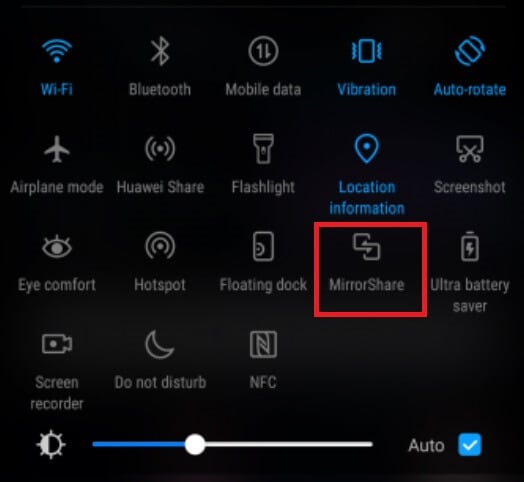
3. You can also go to Settings and select advanced settings.
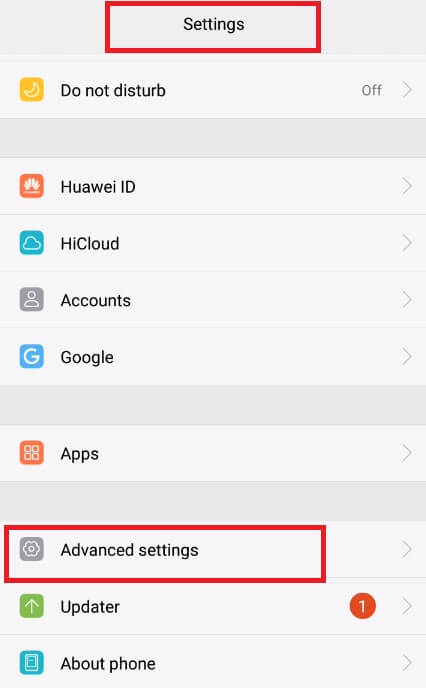
4. Tap on “MirrorShare.”
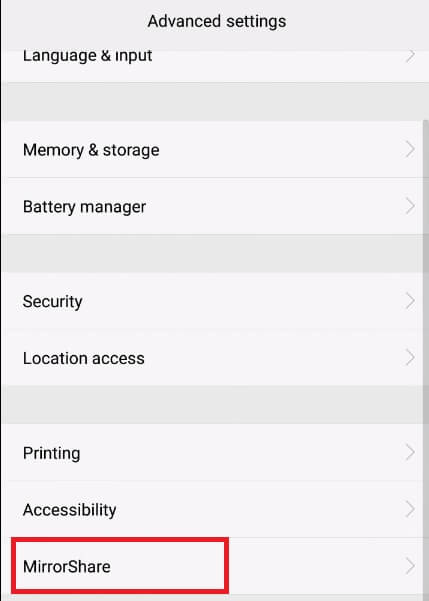
5. From the list of scanned available devices select the name of your TV.

6. On your TV go to network settings.
7. Select the Screen sharing option.
8. Your phone and TV are now connected. You can easily share your files and enjoy the large screen experience.
If you want to stop mirroring just tap on “Disconnect” and your devices are no longer connected.
Part 2. How to Screen Mirroring Xiaomi Redmi 13C 5G to TV?
Screen mirroring Xiaomi Redmi 13C 5G can help you to stream videos on a TV screen. You can use the MirrorShare feature of Xiaomi Redmi 13C 5G to easily connect your phone to any TV. There is no need for a third-party app. Screen Share built-in feature of TV also helps in mirroring the screen of your Xiaomi Redmi 13C 5G set. Just press the home button from remote and select the ScreenShare option. On mobile, swipe down and tap on wireless projection and then choose the name of your TV. In this way, your screen will be shared with the TV. As your devices are now connected you can easily experience your videos or even browse the internet on a large screen.
Part 3. Mirror or Control a Xiaomi Redmi 13C 5G Phone from the Computer using MirrorGo
Huawei is among the top brands that support the Android OS on their phones. Moreover, the Xiaomi Redmi 13C 5G devices are easy to manage. Additionally, you can enable screen mirroring on Xiaomi Redmi 13C 5G smartphones using services such as Wondershare Dr.Fone without any hassle.
The app provides an intuitive interface to connect an Android or iOS device and manage its content with the computer screen. Furthermore, it is a much safer alternative to choppy or sluggish emulators.
Wondershare Dr.Fone
Mirror your Xiaomi Redmi 13C 5G deviceto your computer!
- The application provides the means to share files across the PC and the Xiaomi Redmi 13C 5G device.
- Other than screen mirroring Xiaomi Redmi 13C 5G , you can control the apps and even take screenshots from the computer.
- View multiple notifications simultaneously without picking up your phone.
- Screen Recording is a handy function provided by MirrorGo for streamers.
3,564,710 people have downloaded it
The steps to mirror share Xiaomi Redmi 13C 5G phone on PC with Wondershare Dr.Fone are mentioned below:
Step 1: Connect the Xiaomi Redmi 13C 5G Phone to PC
Use a USB cable to connect the Xiaomi Redmi 13C 5G Android phone with the PC. The app will automatically detect the Xiaomi Redmi 13C 5G device. However, ensure that you have the File Transfer option enabled under the USB Settings. Otherwise, you will not be able to share any content from one platform to another.

Step 2: Access Developer Mode
There are certain options that you will need to enable to fully control the Xiaomi Redmi 13C 5G device with MirrorGo. Head over to the Settings menu and open About Phone. The Developer Mode option will be available there; simply tap on it 7 times.
The next thing that you will need to do is switching on USB Debugging. Remain in the Settings menu and locate the Additional Settings tab. Find the USB Debugging option and toggle it on.

Step 3: Start Screen Mirroring Xiaomi Redmi 13C 5G from PC
Access MirrorGo from the computer. You will see the contents of your Xiaomi Redmi 13C 5G device on the app interface. From there, you can start the mirroring process!
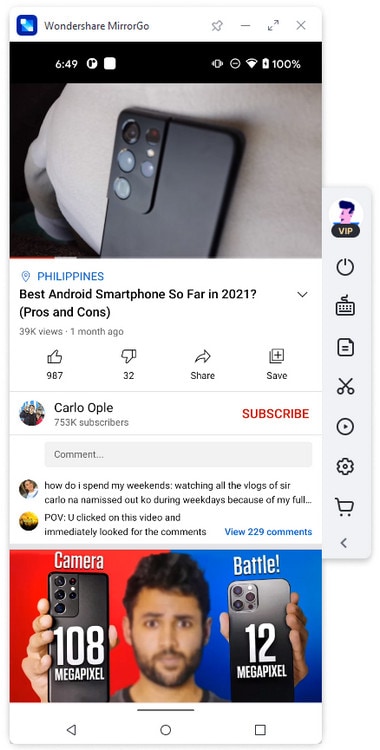
Conclusion
Screen mirroring Xiaomi Redmi 13C 5G to TV or PC is as easy as casting your iPhone screen to any TV or PC. If you are contented with the display of your phone you can use the Mirror share built-in feature of Xiaomi Redmi 13C 5G to stream videos, music, and pictures on TV or PC. A third-party app like MirrorGo Android recorder also facilitates the mirroring of your smartphone to PC. Xiaomi Redmi 13C 5G facilitates its users to a large extent. You can apply the above-mentioned features to cast your phone screen to TV or PC.
Best 3 Xiaomi Redmi 13C 5G Emulator for Mac to Run Your Wanted Android Apps
Mac OS, on the other hand, is a wonderful operating system used by Apple Inc. on it’s Mac PC and MacBook. It has a marvelous user interface and great features. It will be fantastic if we were able to use Android apps on Mac PC. Luckily, it is possible by using an emulator. In this article, we will learn about the five best Android Emulators for Mac.
Part 1. Why You Would Run Android Apps on Mac
- • To run around 1.2 million apps on Mac from Google Play Store.
- • To play tons of Android games on larger screen.
- • People, who spend a good amount of time in front of desktop, will find it more convenient if they were able to use apps like WeChat, WhatsApp, Viber, Line etc. on their Mac.
- • App developer can test their apps on the desktop before sending it to the Google Play Store for user reviewing.
- • Some Emulator supports battery and GPS widgets. So, developers can test their apps based on the battery performance and can also test how their apps will work on different geographical locations.
Part 2. Top 3 Android Emulator for Mac
1. BlueStacks
BlueStacks App Player is probably the most popular emulator for running Android apps on Mac. It is available for both Mac and Windows. It creates a virtual copy of Android OS apps on the guest OS. It uses the unique “LayerCake” technology that allows you to run android apps on your PC without any external Virtual Desktop Application. Once install user can enjoy Android games and apps such as News Feeds, Social Network on a large screen.
BlueStacks maintain an internal search manager that allows any apk, the package file format that is used to distribute and install application and middleware on any Android device, to install within it. It can be
Advantage
- • .apk files can be installed into BlueStacks from Mac simply by double clicking.
- • It can also sync between the apps on Mac and the android phone or tablet by installing BlueStacks Cloud Connect app on Android Device.
- • Apps can be launched directly from Mac dashboard.
- • No need to configure additional Internet connection as it automatically gets the Internet connection of host computer.
- • BlueStacks App Player is available for both Windows and Mac.
Disadvantage
- When running complex graphic apps it fails to respond to the input in a timely fashion.
- It does not provide any mechanism to uninstall cleanly from the host computer.
Download
- • It can be downloaded from the official website of BlueStacks . It is absolutely free.
How to use
Download BlueStacks for Mac OS X from the official website of BlueStacks and install it like any other software on your PC. Once installed, it will boot up to its Home Screen. From there you can find the installed apps, find new apps in the “Top Charts”, search apps, play games and change settings. Mouse will be the basic touch controller. To access Google Play you will have to associate a Google Account with BlueStacks.
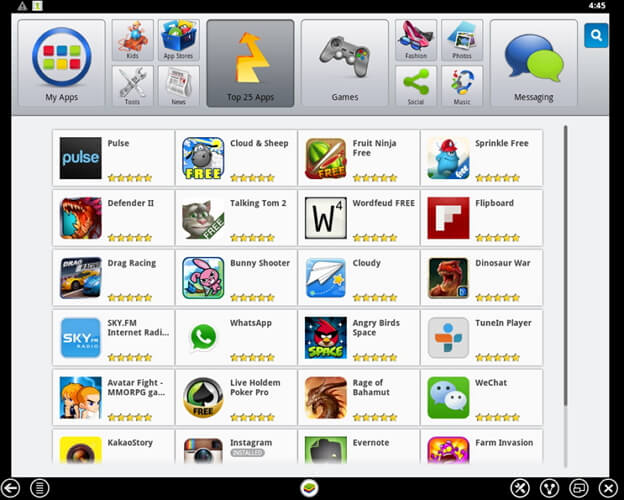
2. Genymotion
Genymotion is a fast and wonderful third party emulator that can be used to create a virtual environment for Android. It is the fastest Android emulator on the earth. It can be used to develop, test and run Android apps on Mac PC. It is available for Windows, Mac, and Linux machine. It is easy to install and can create a customized android device. You can start multiple virtual devices at the same time. It has the pixel perfect functionality so you can be precise to your UI development. By using the OpenGL acceleration it can achieve the best 3D performance. It directly commands the virtual devices sensors with Genymotion sensors. It is evolution of the Android open source project and already trusted by about 300,000 developers around the globe.
Advantage
- • Best 3D performance is achieved through OpenGL acceleration.
- • Support full screen option.
- • Can start multiple virtual devices at the same time.
- • Fully compatible with ADB.
- • Available for Mac, Windows and Linux machine.
Disadvantage
- • Require virtual Box to run Genymotion.
- • Cannot deploy Android machine offline.
Download
- Genymotion can be downloaded from the official website of Genymotion. The latest version of Genymotion is 2.2.2. You have to choose a package that meets your requirements.
How to use
- 1. Download Genymotion. You have to create an account to download it.
- 2. Open the .dmg installer. It will also install Oracle VM Virtual Box on your computer.
- 3. Move the Genymotion and Genymotion Shell to application directory.
- 4. Click the icon from Application directory and the following window will appear.
- 5. To add virtual device click on the add button.
- 6. Click on the connect button.
- 7. Enter your user name and password to connect to the Genymotion Cloud and click on the connect button. After connecting with the Genymotion cloud the following screen will appear.
- 8. Select a virtual machine and click on Next.
- 9. Give a name for the Virtual machine like below and click on Next.
- 10. Your virtual device will be now be downloaded and deployed. Click on the Finish button after successful deployment of your virtual machine.
- 11. Click on the Play button to start the new virtual machine and enjoy.
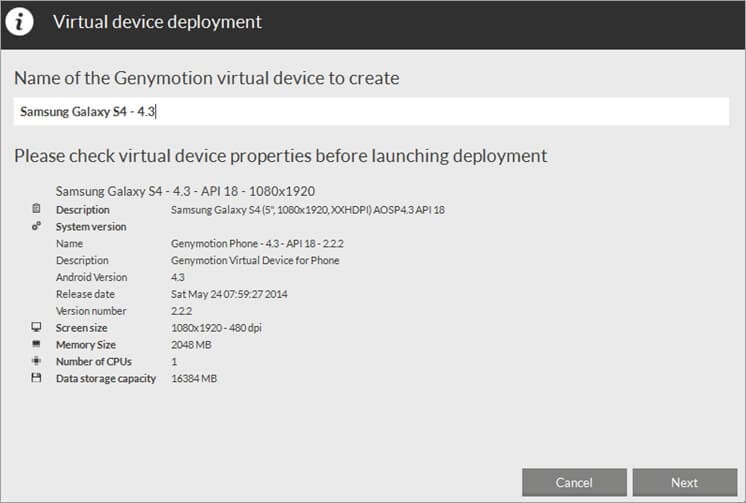
3. Andy
Andy is an open source emulator that allows developers and users to enjoy more robust apps, to experience them in multiple device environments, and to stop being constraint by the limits of device storage, screen size or separate OS. User can update their Android through Andy. It provides seamless sync between desktop and mobile device. User can use their phone as joystick while playing games.
Advantage
- • It provides a seamless sync between desktop and mobile device.
- • Enable Android OS update.
- • Enable app download from any desktop browser to Andy OS.
- • Phones can be used as joystick while playing games.
- • Unlimited storage expansion.
Disadvantage
- • Increase CPU usage.
- • Consumes a lot of physical memory.
Download
- • You can download Andy from <www.andyroid.net>.
How to Use
- 1. Download and install Andy.
- 2. Launch Andy. It will take about a minute to boot and then it should see a welcome screen.
- 3. Sign into your Google Account and complete the rest of the setup screen. You will be asked to provide your Google Account Information to 1ClickSync, the app that let’s you sync between Andy and the mobile device

Recommended Best Applications for Mirroring Your Xiaomi Redmi 13C 5G Screen
Smartphones are much more advanced now, allowing users to stream types of content in high-definition easily. However, regardless of your phone type, the screen will seem too small for multiple people to see their content together. Using a mobile screen mirroring app can help there.
For example, you are watching a movie on your phone with friends, but no stand is available for phone rest, and the screen is too small. You can use a capable share screen app Android feature to mirror the screen on another device from a smartphone. Read to learn how.
Best Apps for Mirroring Screens in Android Smartphones
Before discussing the methods in detail, let us briefly look at the different types of mirroring methods you can trust in this regard.
| Mirror and Control | Easy of Use | Pricing | |
|---|---|---|---|
| Dr.Fone Air - Online Screen Mirror | Yes | High | Free |
| Screen Stream Mirroring | Yes | High | Free with in-app purchases |
| LetsView | Yes | Medium | Free |
| Pushbullet | Yes, with limitations | Medium | Free |
| Pro- USD 4.99 (monthly) or USD 39.99 (yearly) | |||
| TeamViewer | Yes, with limitations | Medium | Premium- USD 37.88/month |
| Corporate- USD 80.67/month | |||
| Vysor | Yes | High | Starts at USD 2.50 |
| AirDroid Cast | Yes | High | Free |
| Remote Casting- USD 2.49/month | |||
| Cast & Control- USD 3.49/month | |||
| Cubetto | Yes, with limitations | Medium | USD 20.17 |
| Unified Remote | Yes | High | Starts at USD 1.82 |
| Roku | Yes | High | Starts at USD 29.99 |
| Mobizen | Yes | High | Free |
| Standard- USD 12/month | |||
| MirrorGo | Yes | High | Starts at USD 19.95 |
Let’s get more in-depth on the different solutions available for choosing the best screen- sharing app for Android.
1. Dr.Fone Air - Online Screen Mirror
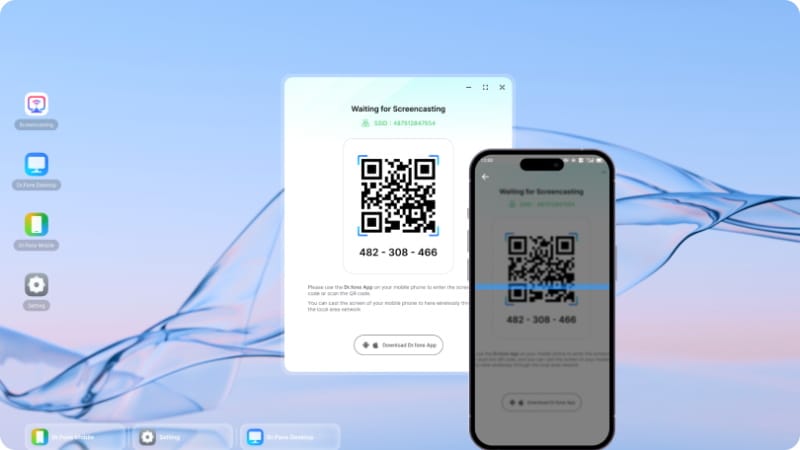
One efficient and user-friendly screen-mirroring app for Android and iPhone devices is the Wondershare Dr.Fone Air software. The app helps share screens from your mobile device and control how to view the content on the screen. Activating the function is not complex either here.
Price: Free
Pros:
- Completely share screens across different platforms easily.
- Control how to view content on the computer screen, like rotating, zooming in and out, etc.
- Quick, effortless mirroring process.
Cons:
- One cannot directly activate it through scanning.
How does it work?
- Visit the Fone Air official website on the computer. Launch the Dr.Fone Link app and connect your phone and computer using one WiFi network.
- Use the Dr.Fone Link app to scan the QR Code or enter the Cast Code to connect both devices.
- Screen mirroring will be when the two devices connect.
2. Screen Stream Mirroring

Use this screen mirroring app for Android mobile users to smoothly mirror the screen using tools and media players like XBMC/KODI, VLC, and more. The Screen Stream Mirroring Android app is efficient for browser-to-device screen sharing and broadcasting content easily across platforms. Also, get an on-screen stopper and timer to use while streaming.
Price: Free with in-app purchases.
Pros:
- Get the widget of the camera overlay during the streaming process.
- Easily screens share using web browsers.
- Possible to broadcast entertainment and game streams.
Cons:
- If you did not root the Xiaomi Redmi 13C 5G device, a startup tool is needed for screen mirroring.
- Time limits are available for free plan users.
How does it work?
- Download the app. If no rooting has been done, activate the startup tool.
- Follow-on screen steps and then run it. Please switch off the Xiaomi Redmi 13C 5G device and restart it again.
- The screen mirroring will activate.
3. LetsView

One of the best tools for Android users for a safe and effective screen mirroring process is the LetsView app. With this tool, one can easily screencast their phone content on external screens, like computers and television. Unlike some other options, you can do that without USB plugging here and activate via QR code scanning/PIN code.
Price: Free
Pros:
- Quick mirroring process.
- Works to cast Android screens on different branded television devices.
- Use one WiFi network to sync the Xiaomi Redmi 13C 5G devices.
Cons:
- It does not work offline.
- Lagging issues can occur midway.
How does it work?
- Connect all devices to one WiFi network.
- Access the LetsView app. Find the Xiaomi Redmi 13C 5G device to mirror.
- Choose the Xiaomi Redmi 13C 5G device name that appears as “LetsView + device-name”. Upon selection, the mirroring process will occur successfully.
4. Pushbullet

For easy phone screen sharing and mirroring usage, you can trust the Pushbullet software. The app allows smooth Android phone screencasting support to users and is simple to use for mirroring full-screen notifications, messages, and more.
Price: Free, Pro- USD 4.99 (monthly) pr USD 39.99 (yearly)
Pros:
- Easily use this to share links and media files.
- Chat with different users on mirrored screens on other devices.
- Get notifications regarding calls, texts, emails, etc.
Cons:
- The file-sending limit is capped at 25 MB.
- Action support for mirrored notifications is not supported for Free plan users.
How does it work?
- Download the app on your phone and activate it after registering with your account.
- Then, download the app on the desktop. Sign in when prompted.
- Link other devices and begin using the features.
5. TeamViewer
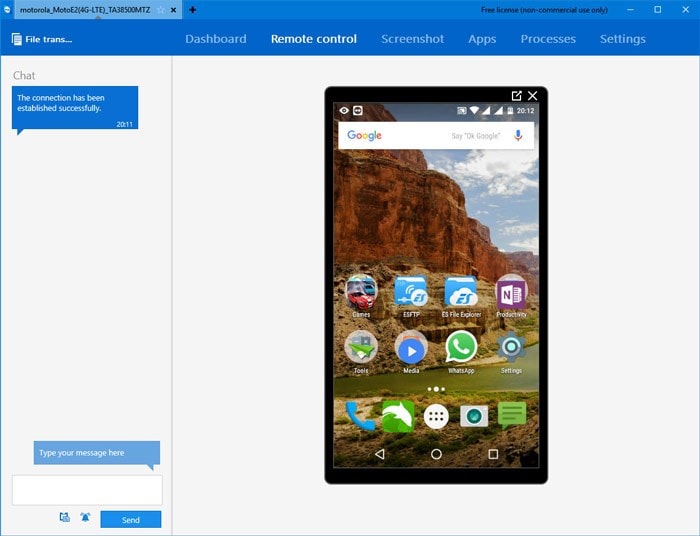
TeamViewer is another useful screen mirroring app for Android for improved management and control of professional processes from any device. With this effect, you can access different apps and files on mobile devices and computers, especially with screencasting functionality.
Price: Premium- USD 37.88/month, Corporate- USD 80.67/month
Pros:
- Strong 256-bit AES encryption is available.
- Works on different devices.
- No installation or registration is necessary.
Cons:
- Mainly useful for professional teams only, so features are suitable for a niche group of users.
- Mass deployment (MSI) is only available for Corporate plan users.
How does it work?
- Download and install the app on your computer and access the TeamViewer QuickSupport app on your phone. Get the displayed unique ID.
- Go to Start on Windows and launch the TeamViewer app.
- Add the unique ID > Connect to Partner > Allow.
- Tap on Start Now next.
6. Vysor
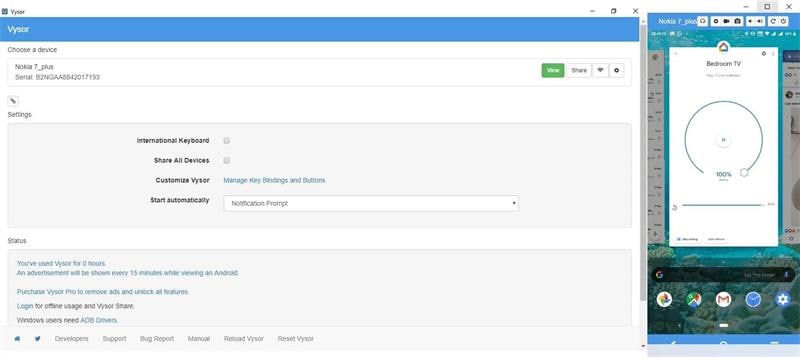
The following Android screen share app that we recommend is Vysor. The app is simple to navigate and comes with multi-platform compatibility support. You can choose which content to cast on the bigger screen through your Android phone and use a QR code/USB to connect and stream effortlessly.
Price: In-app purchase with cost starting at USD 2.50 per month.
Pros:
- Easily take screenshots of screened control.
- Activate and control your mirrored Android phone screen.
- Vysor Pro users get a variety of features, like full-screen support.
Cons:
- Free users do not get wireless support.
- Drag and drop functionality is not allowed for free plan users.
How does it work?
- Download the app on both mobile devices and computers separately and launch them.
- Use a USB Type C cable to connect both devices.
- Complete USB debugging processes via your browser by allowing Vysor access to it.
- Then, control the screen mirroring effect.
7. AirDroid Cast

With AirDroid Cast, users can experience a high-quality screencasting experience from different phones or websites. Choose which channels and content you will have the chance to mirror on other screens easily. Various plans are available catering to different user needs.
Price: Free, Remote Casting- USD 2.49/month, Cast & Control- USD 3.49/month
Pros:
- Get two-way audio support.
- Quickly cast across different screens and devices.
- Use wireless cross-platform streaming functionality.
Cons:
- Only the Cast + Control plan version allows users the ability to control the cast Android screens.
- You can sync only one device with the Free plan.
How does it work?
- Download software on devices.
- Add the Cast code, Scan the QR code, or work with a USB cable to connect the two devices.
- The mirroring will activate on the second screen.
8. Cubetto
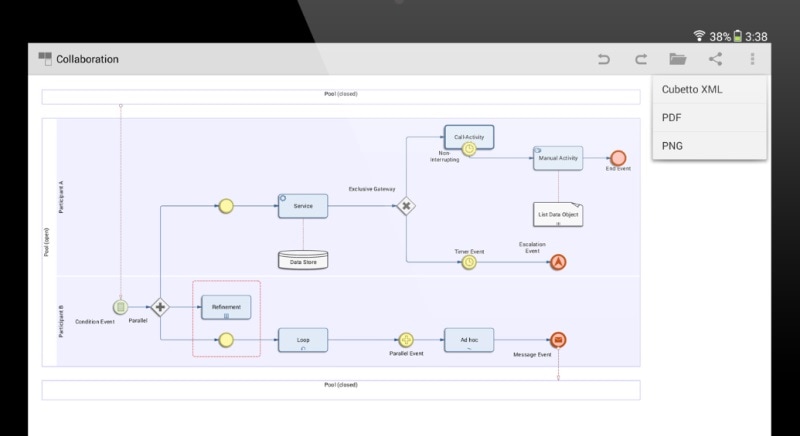
This app allows you to create and manage different diagram models and flowcharts for meetings. You will get auto-layout set up for all the diagrams you don’t have to handle manually. Prepare your models in different languages, and mirror them to varying devices.
Price: USD 20.17
Pros:
- Host meetings via screen mirroring on tablets and phones.
- Prepare and add customized attributes for all object types.
- Prepare project and diagram copies.
Cons:
- Valid for a niche group of users only.
- You cannot use this for personal content mirroring needs.
How does it work?
- Download, install, and launch the app on an Android phone.
- Use features available to monitor the auto-created flowcharts and diagrams.
- Export finished files in the supported formats or share them on other platforms via screen mirroring.
9. Unified Remote
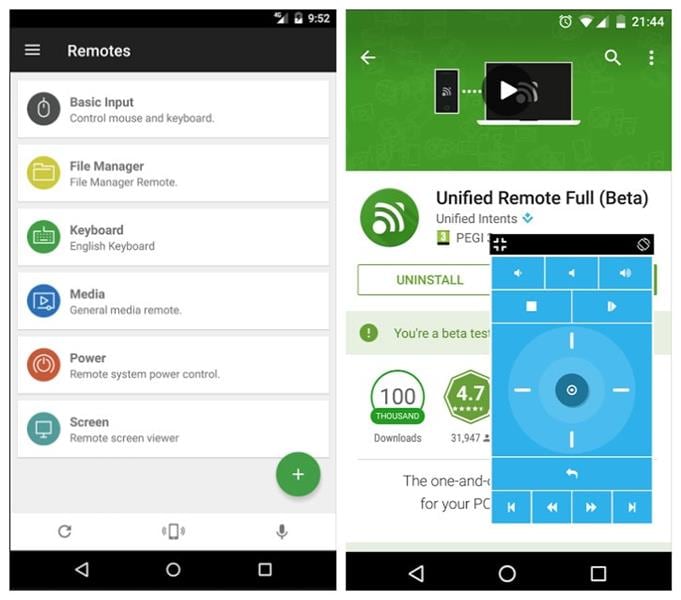
Unified Remote is one of the best screen share apps for Android users to try out. After activating this feature on your computer, you can mirror what’s in view on mobile devices. The mouse support here allows users to utilize the multi-touch or single-touch functionality for more accessible controls.
Price: In-app cost starts at USD 1.82.
Pros:
- Control different types of devices with varying remote devices.
- Easily control various media sources, like Netflix, iTunes, Spotify, etc.
- Simple screen mirroring process between computers and mobile phones.
Cons:
- You must invest in additional solutions for the mirroring process since it only works via a local network.
- Unable to control another Android phone from the first one.
How does it work?
- Download and activate the app on your mobile device.
- Install the Unified Remote Server on your computer.
- Connect to the server from your app on an Android phone via Bluetooth or WiFi. Screen mirroring will begin.
10. Roku
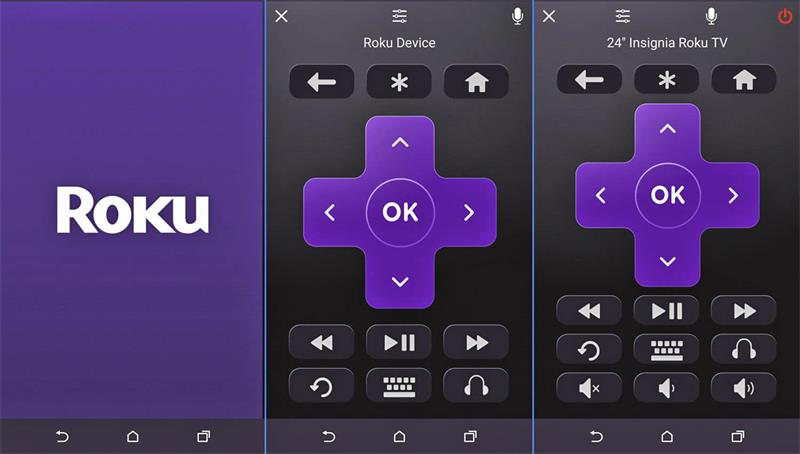
With this app, you can basically work it for streaming games and media from different apps and platforms. Choose between the various available channels, select the main content you wish to cast to another device, and continue using the tools available to control your actions.
Price: Starting at USD 29.99.
Pros:
- Stream different types of channels from global network providers and channels.
- Many languages are supported.
- Control and monitor your account and settings through the app.
Cons:
- You need to invest in additional devices.
- Slightly tricky for total beginners to handle at first.
How does it work?
- Power your Roku device up.
- Connect the Xiaomi Redmi 13C 5G device to the active network connection you are using.
- Register for a Roku account. Then, activate the connection and begin screencasting on another device.
11. Mobizen
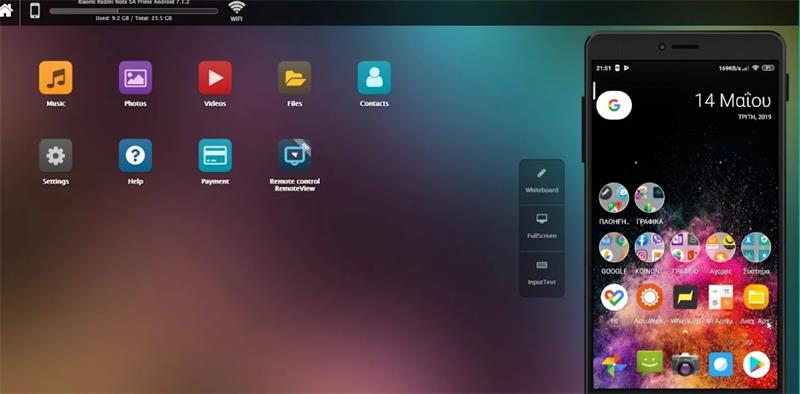
With Mobizen, it is straightforward to do quick and high-quality live broadcasts from a computer or mobile phone. You can mirror your videos through the Android device easily after activating this app.
Plus, for users creating game content to stream, this app helps do that. Connect to other significant sites like Twitch and YouTube for broadcast sharing and easily mirror your screen.
Price: Free, Standard- USD 12/month
Pros:
- Prepare broadcasts in real-time with many features for pre-production streaming.
- You can invite more participants easily for partnered podcasts.
- Add custom logos.
Cons:
- Limited types of content to edit and stream.
- QHD (2k) broadcasting is only available for paid plan users.
How does it work?
- Activate the Mobizen recorder function while playing a mobile game and record it.
- Download the file to the computer.
- Then, log in to the Mobizen site and prepare a scene with the recording.
- Live broadcast it to another platform.
12. MirrorGo

This particular mobile screen mirroring app for Android allows its users to easily mirror their Android phone to the computer screen via a WiFi connection. It is possible to record the Android phone and portray that across devices with MirrorGo. Plus, you can easily capture screenshots, transfer files, and more.
Price: Monthly- USD 19.95; Quarterly- USD 9.98/month; Annual- USD 3.33/month
Pros:
- High-quality screen capturing function in HD.
- You can easily sync your game data across platforms.
- Quickly recording the videos while streaming.
Cons:
- Not available for free.
- Only usable on 5 different devices per license.
How does it work?
- Sync the Android phone with your computer.
- Activate the USB debugging process on the mobile.
- Enable the mirroring process, and the screen will be cast on your computer quickly.
Conclusion
Indeed, all of the options mentioned in this list are commendable choices for screen mirroring. While each provides practical benefits and comes with some drawbacks, they are helpful to a specific group of users.
Different types of users can benefit from Dr.Fone Air - Online Screen Mirror, which makes it a suitable choice overall. However, consider their usability and functions before making your final decision.
Also read:
- [New] Innovations in YouTube Video Editing Software Reviewed
- [Updated] 2024 Approved Expert Tips & Strategies to Make Your Podcast Title Stand Out
- [Updated] Breaking Down YouTube Short Barriers
- [Updated] In 2024, A Step-by-Step Guide to GoPro Time-Lapse Mastery
- Best 3 Xiaomi Redmi K70 Pro Emulator for Mac to Run Your Wanted Android Apps | Dr.fone
- Can I use iTools gpx file to catch the rare Pokemon On Oppo Find N3 Flip | Dr.fone
- Comprehensive Review: How the Samsung Galaxy Tab S7 Measures Up in the Mid-Tier Android Tablet Category
- HasteNotHalt SlowMotion Tape
- How to Mirror Your Nokia C02 Screen to PC with Chromecast | Dr.fone
- How To Stream Anything From Xiaomi Redmi A2 to Apple TV | Dr.fone
- In 2024, How to Mirror Samsung Galaxy A23 5G to Mac? | Dr.fone
- In 2024, How to Screen Mirroring Xiaomi Civi 3? | Dr.fone
- In 2024, How To Stream Anything From Oppo A79 5G to Apple TV | Dr.fone
- In 2024, How Vivo Y02T Mirror Screen to PC? | Dr.fone
- In 2024, The Best iSpoofer Alternative to Try On Vivo S17 | Dr.fone
- In-Depth Look at Mac's Top Screen Capture Apps for 2024
- Process of Screen Sharing Vivo Y27s to PC- Detailed Steps | Dr.fone
- Title: 3 Facts You Need to Know about Screen Mirroring Xiaomi Redmi 13C 5G | Dr.fone
- Author: Seraphina
- Created at : 2025-01-29 20:34:40
- Updated at : 2025-01-31 00:57:48
- Link: https://screen-mirror.techidaily.com/3-facts-you-need-to-know-about-screen-mirroring-xiaomi-redmi-13c-5g-drfone-by-drfone-android/
- License: This work is licensed under CC BY-NC-SA 4.0.
